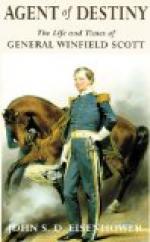Orders were accordingly issued assigning officers to their respective duties. Captain Ethan A. Hitchcock, First Infantry, was announced Assistant Inspector General of the Department, and Lieutenant James Farley Izard, of the Dragoons, to be Acting Brigade Major. The artillery and infantry of the United States army, together with the Louisiana volunteer forces under Adjutant-General Persifor F. Smith, were to constitute “the light brigade.” (Here is an instance of a staff officer being assigned to command troops.) The whole force to be under the command of Lieutenant-Colonel David E. Twiggs, Fourth Infantry.
The Louisiana volunteers were divided into two battalions, the first composed of the companies of Captains Burt, Lee, Williams, Rogers, and Thistle, under Lieutenant-Colonel Thomas Lawson, Surgeon. (Here is another case of a staff officer and surgeon ordered to the command of troops.) The second battalion was composed of the companies of Captains Samuel F. Marks, William H. Ker, Magee, Smith, Abadie, and Barr, under Major Marks, the regiment to be commanded by Colonel Persifor F. Smith. Orders for marching were issued on the 13th, the troops to be supplied with forty rounds of ammunition and ten days’ rations, five of which were to be carried in haversacks. During the Florida campaign the only articles drawn by the private volunteer soldiers were bread or flour, pork or beef, while only a few drew salt, sugar, and coffee. Major Richard M. Sands, of the Fourth Infantry, and Captain Barr’s company of volunteers, amounting in all to one hundred and sixty men, were detailed for the protection of the fort, under command of Major Sands.
The army marched in three columns, equidistant one hundred yards, with a strong advance and rear guard. The center column was composed of one company of volunteers as advance guard, under command of Brigade Major Izard. Seven companies of United States artillery and infantry, under command of Lieutenant-Colonel William Sewell Foster; the baggage train, led by Captain Samuel Shannon; six companies of Louisiana volunteers as rear guard, under command of Lieutenant-Colonel Lawson. Right column: Four companies of artillery acting as light infantry, under command of Major Belton. Left column: Four companies of Louisiana volunteers, under command of Major Marks. The entire command consisted of nine hundred and eighty effective men, exclusive of the detachment under Major Sands, which, added to the force, would make it eleven hundred and forty men.




